On Dec. 17, Henrik Lundqvist dropped a bomb on the Washington Capitals’ 2020 season plans.
Some tough news I need to share with you all.. pic.twitter.com/y7ZtAoo39Q
— Henrik Lundqvist (@hlundqvist35) December 17, 2020
The marriage of the man they call “The King” and the Capitals was supposed to be perfect. An aging, future hall-of-fame goaltender with some gas left in the tank was going to suit up in the same locker room with the best goal scorer of his generation. Lundqvist would’ve brought professionalism and a calming influence to the Capitals’ goaltending corps. If Samsonov faltered, it would be ok; Lundqvist was there to make everything alright. Alas, it was not to be, and now the Capitals have a gaping hole they need to fill.
Free Agency Options
The signing of Lundqvist at the start of free agency sent a clear message that the organization was not comfortable going into the season without adding talent at the goaltending position. An inexpensive free agent goaltender is the ideal fix because they do not have to expend any assets beyond salary to acquire them. The Capitals are back to the position they were in prior to signing Lundqvist. The pool of goaltenders left available in NHL free agency is sparse, but there are a couple of options available that would make sense for the team.
RELATED: Capitals Have Limited Options With Lundqvist News
The Capitals are up tight up against the salary cap, placing a limit on what they can do without moving some money around. It seems likely that Lundqvist will be moved to long-term injured reserve, providing the Capitals with $1.5 million of salary cap relief. This will give them the wiggle room they need to sign a free agent goaltender.
Jimmy Howard
Jimmy Howard will turn 37 in March and has over 500 NHL starts under his belt. Last season was a tremendous struggle for the aging netminder. He turned in a statistically disastrous season with the Detroit Red Wings, posting a 2-23-2 record through 27 starts. His save percentage (SV%) was .882, and his goals against average (GAA) ballooned to 4.20.
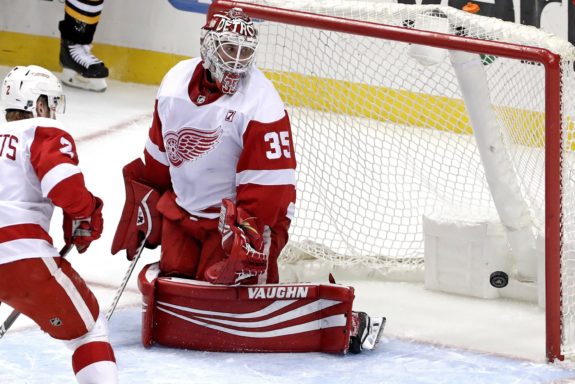
It’s tough to put all that on Howard alone. The Red Wings were historically bad last season. Their 17 wins in 2019-20 are their worst total since 1986 and tied for their seventh-worst all time. Of the six seasons with fewer wins, five of them were before World War II in 44 and 48 game seasons. The 2019-20 team was 31st in the league for goals for and 31st for goals against. They allowed a league-worst high danger conversion rate of 14.7%. Those numbers make it very difficult to get a fair assessment of where Howard is as a player because he was on a really bad team.
As recently as 2019, though, Howard was an average-level NHL starting goaltender. His .909 SV% from 2019 is around the average SV% that is acceptable for an NHL netminder. The 2020 Capitals were the sixth-best team at preventing scoring chances against in the NHL last season. They’ve retained and upgraded that defensive unit. With a backup’s work-load and a good defense in front of him, Howard could bounce back and be a goaltender that does enough to give his team a chance to win.
Garret Sparks
Garret Sparks does not have an NHL contract. The former Calder Cup winner was jettisoned from the Toronto Maple Leafs during the summer of 2019 after a tumultuous tenure. After his departure, Toronto did not see an improvement in their backup goaltender department. It was a major point of weakness for them for much of their 2019-20 campaign, insinuating that maybe Sparks wasn’t the problem. Across two seasons with the Maple Leafs, he posted a 14-18-2 record, averaging a .898 SV% and a 3.09 GAA. For this, he was basically run out of town in Toronto.
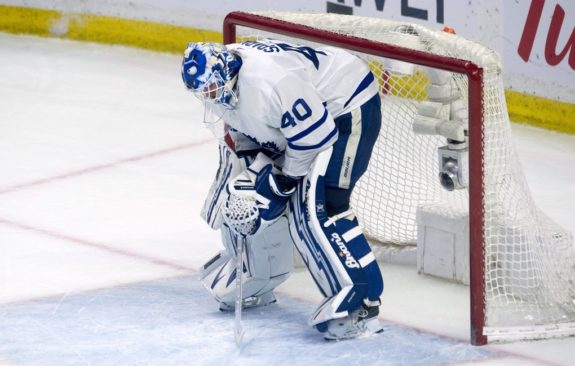
It’s worth remembering that Sparks’ two seasons with the Maple Leafs were quite some time apart. His rookie season was the 2015-16 season where the Maple Leafs were in a race to the bottom to attempt (and succeed at) drafting Auston Matthews. His 2018-19 campaign by itself was not the type of abomination that should cause a backup goaltender to be cast away. In 17 starts, he posted a .902 SV% and a 3.15 GAA.
Those numbers aren’t great, but the Maple Leafs’ defense in 2019 was brutal. Sparks became a scapegoat even though he only accounted for 17 starts of an 82 game season. One season later, the Maple Leafs would turn over more than 50% of the defensive unit, fire a head coach and still not fix the issues that contributed to Sparks’ woes.
What makes Sparks so attractive to the Capitals is a combination of factors. He’ll turn 28 in June of 2021. Of the free agent goaltenders with NHL experience floating around, he’s far and away the youngest. He’s also currently playing with the Orlando Solar Bears of the ECHL. No NHL team holds his rights, and the AHL is in limbo right now.
The lack of a guaranteed AHL season means that if Sparks sees a real chance to seize an NHL backup job, it’s likely a team could bring him in for a salary in the league minimum range. This would be very helpful to the Capitals due to their salary cap situation. His current play in the ECHL means that Sparks’ conditioning is such that he’s already in competitive game-shape. There’s been a long layover for some players due to COVID-19, but Sparks has a head start on other goaltenders. This, combined with inexpensive salary demands and relative youth, helps make him a favorable option.
The Capitals would also be the best defensive unit Sparks has ever played behind. Even the .902 SV% he posted that got him run out of Toronto is still better than the .897 posted by the Capitals’ starter Brayden Holtby in 2019-20. The Capitals made the playoffs with their starting goaltender posting a below-average SV%, and Holtby played behind one of the top defensive units in the game.
| SCA | GP | SCAPG | |
| 2018-19 Maple Leafs | 1855 | 82 | 22.62 |
| 2019-20 Capitals | 1327 | 69 | 19.23 |
GP= Games Played
SCAPG:= Scorping Changes Against per game
All stats are at 5-on-5
During 5-on-5 play, the 2018-19 Maple Leafs, on average, surrendered 3.39 more scoring chances per game than the 2019-20 Capitals. It’s not unreasonable to believe that given a better defense and better overall team in front of him, Sparks could be at least a serviceable NHL backup goalie.
Trade Options
If they do not sign a free agent, there’s a multitude of theoretical trade options the Capitals could explore. I’ve chosen to key in on the ones that I think are the most reasonable for them to pursue. These players have varying levels of experience, but the common thread that unites them is that they are all currently third on their respective teams’ goaltending depth charts while also being competent NHL backups.
Third goaltenders often are assigned to the AHL. The last official update from the AHL website is from Oct. 28th, setting Feb. 5th as a start date. The changing situation from October to now (Dec. 25th) leads me to believe this date to be in jeopardy. The AHL is highly dependent on gate based revenue for survival and does not have a business model that works without being able to welcome fans to their buildings. If the current COVID-19 situation does not improve drastically by Feb. 5th, it is unlikely fans will be allowed to attend games in many states that house AHL arenas. Unfortunately, no fans likely mean no AHL season.
Anthony Stolarz
Whether or not the Anaheim Ducks would make Anthony Stolarz available hinged on Ryan Miller. They originally brought Stolarz in on a two-year contract in July of 2019. He only played one game for the Ducks and spent the majority of the season with their AHL affiliate, the San Diego Gulls. This is due in large part to the quality of backup goaltending provided to the Ducks by Miller.
In spite of being 40 years old this season, Miller continues to truck forward. The decision to bring him back this season would put Stolarz back with the Gulls, where in 2019-20, he provided excellent goaltending to the tune of 2.66 GAA and a .922 SV%.

Stolarz is still only 26 years old and could have a future as an NHL backup ahead of him. He spent limited time in this role for the Philadelphia Flyers and Edmonton Oilers with mixed results. Whether or not the Ducks are willing to part with him is now a decision they have to make. He is 14 years younger and has a lower salary than Miller, but Stolarz is still third on the depth chart.
His contract expires after this season, and he’s an unrestricted free agent. The Ducks have no guarantee he’ll be around next season if Miller decides to retire after this one. This creates a situation where it’s difficult for the Ducks to demand too much in the way of compensation in trading away Stolarz. A fourth-round pick is the maximum I could see this trade costing the Capitals.
Dustin Tokarski
Dustin Tokarski has been an NHL backup before. It’s been a long time since the 31-year-old veteran was an NHL regular. Since 2015-16, Tokarski has only seen action for 10 minutes of ice time on NHL ice. He’s currently under contract with the Buffalo Sabres organization to play for their Rochester AHL affiliate. With the AHL season currently an unknown, the Sabres could see fit to acquire something in return for Tokarski. His AHL résumé is quite extensive, with a record of 192-120-33.
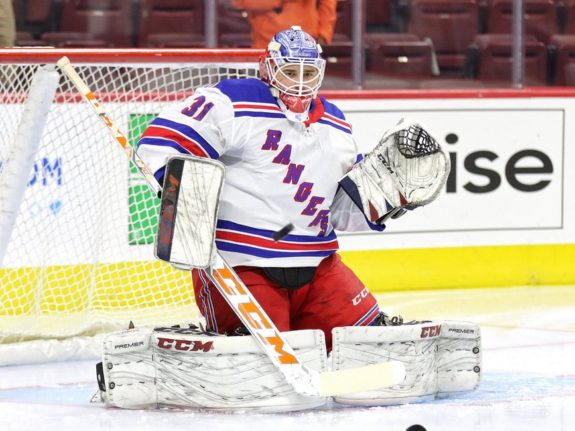
Tokarski is a guy who has been in the show before, and teams have felt that in an emergency they could count on him if needed. That’s why he has continued to get NHL contracts in spite of not seeing NHL ice for four years. The Sabres signed him to a two-year contract, with an annual cap hit of $725,000. With the Capitals tight to the cap, it wouldn’t be too difficult to find that amount of space. Tokarski might not be the most inspiring option as a backup, but he would be inexpensive to maintain.
The cost to obtain him would depend on how difficult the Sabres wanted to make things in the wake of divisional realignment. For this season, the Sabres and Capitals find themselves in the same division. Teams occasionally resist trades within their division. However, they have other, younger netminders in their stable, so they might be willing to inexpensively part with their AHL insurance policy, especially if it continues to look like the AHL might not have a season.
Adin Hill
Adin Hill could be a hot commodity sooner rather than later. His work standing in for the Arizona Coyotes through some injuries at the goaltender position was admirable last season. The 24-year-old, 2015 third-round pick has been playing in the AHL since he was 20. Since 2016-17, Hill has appeared in 136 AHL contests and 30 NHL contests. Last season’s body of work saw him post a .918 SV% and 2.62 GAA average in 13 games.
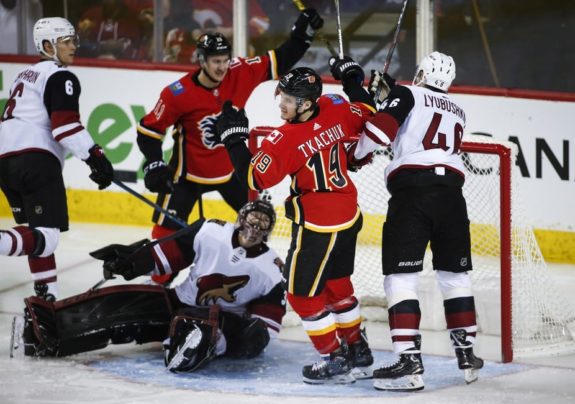
Antti Raanta’s $4.25 million contract expires after this season. Darcy Kuemper is on board for an additional year after this one. If the Coyotes were to part with a netminder, it seems likely they’d want to move Raanta’s contract out. Even with 50% salary retention, though, the Capitals could not afford to take on Raanta without making some other moves. Raanta would be a great get and great move for the Capitals in the short term, but it could be difficult to make the money work.
That brings us back around to Hill, who only makes $800,000 against the cap and is a restricted free agent after this season. He’s almost certainly considered the heir apparent to the backup position with the Coyotes once Raanta’s contract is up. This makes his relative value much higher than the other trade options I mention are to their respective teams. Hill factors heavily into his current franchise’s future plans.
The reason the Coyotes might be willing to part with Hill is that they find themselves in a very difficult situation in other aspects of the franchise. Their new general manager is without a first or third round pick in the 2021 Entry Draft, and it looks like they might be restarting their rebuild.
If the opportunity presents itself to add quality draft/prospect assets, he has to at least consider it. To acquire Hill, the Capitals would likely have to part with, at minimum, their 2021 second-round pick. That certainly seems like a big price to pay, but acquiring Hill would be a move for the future beyond this season for the Capitals.
Anders Nilsson
Anders Nilsson seems to have lost favor to Marcus Hogberg for the number two job with the Ottawa Senators. In my viewings of the Senators last season, I would consider Hogberg and Nilsson to be pretty close in terms of ability and performance. The numbers back that statement up, with both goaltenders turning in similar stat lines last season.
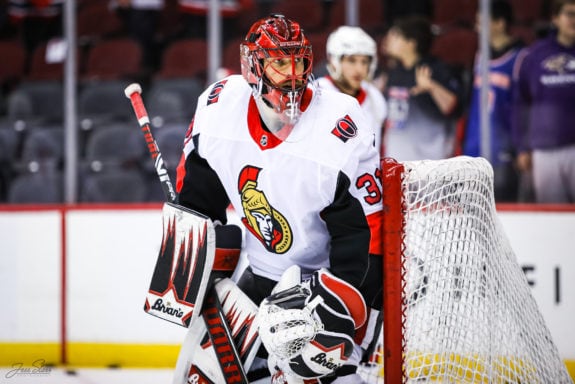
Nilsson is not a new name to the NHL game. He has 161 regular-season games played between six teams since 2012. The 6-foot-6, 30-year-old Swedish netminder has occasionally shown glimpses of potential to take on a bigger workload during his career. Unfortunately, he has never been able to achieve the consistency necessary to take that next step. He has also never really played behind a particularly good team. It would be interesting to see what he could be capable of behind solid defense, such as the Capitals, with the goal support to back him up if he were to get into trouble.
If, indeed, Hogberg has taken over as the primary backup for the Senators, Nilsson’s $2.6 million salary becomes expendable. In order for the Capitals to take on that salary, they have to make space. That might lead to the Senators taking a depth player contract like Richard Panik or Garnet Hathaway back in the trade. Defender Nick Jensen and his $2.5 million cap hit could also be in play here. Trevor van Riemsdyk is a less expensive third-pairing option, and prospect defenders could push for roster spots.
If the Senators were willing to retain some of Nilsson’s salary, it would make it easier to complete the deal. Perhaps the Capitals could sweeten the deal with a later round draft pick to convince them to retain some salary. The money is the only real major complication here. The Senators getting Jensen, Hathaway or Panik in exchange for their third goaltender is a good move for them. The Capitals have enough depth in-system that they could afford to part with one of those players in order to obtain a solid backup goaltender.
RELATED: Capitals Have Significant Issues to Face This Season
The loss of Lundqvist forces Capitals’ general manager Brian MacLellan to reassess his backup goaltender situation. The signing of Lundqvist made it clear that they weren’t content to turn the position over to players already within the organization. Their shortened, condensed schedule contains eight back-to-backs and seven weeks where they will play four games in one week. If the Capitals are going to position themselves well for a deep playoff run, they are going to be reliant on having a good backup goaltender. As the situation currently stands, they’re going to have to go out and get one.